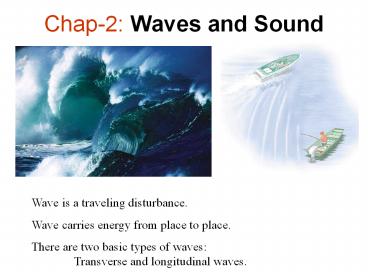Chap-2: Waves and Sound - PowerPoint PPT Presentation
Title:
Chap-2: Waves and Sound
Description:
Chap-2: Waves and Sound Wave is a traveling disturbance. Wave carries energy from place to place. There are two basic types of waves: Transverse and longitudinal waves. – PowerPoint PPT presentation
Number of Views:192
Avg rating:3.0/5.0
Title: Chap-2: Waves and Sound
1
Chap-2 Waves and Sound
Wave is a traveling disturbance. Wave carries
energy from place to place. There are two basic
types of waves Transverse and longitudinal
waves.
2
Transverse waves
A transverse wave is one in which the disturbance
is perpendicular to the direction of travel of
the wave. Examples Light wave, waves on a guitar
string.
3
Longitudinal Waves
Longitudinal wave is one in which the disturbance
is parallel to the line of travel of the wave.
Example Sound wave in air is a longitudinal
wave.
4
Water Waves
Water waves are partly transverse and
longitudinal.
5
Electromagnetic wave
Electric and magnetic fields fluctuating together
can form a propagating electromagnetic wave.
6
The Electromagnetic Spectrum
7
Difference between sound and lightBell-in-Vacuum
8
Periodic Waves
Periodic waves are waves that repeat.
9
Amplitude, Wavelength, and Period
The amplitude, A is the maximum disturbance. The
wavelength, ? is the horizontal length of one
cycle of the wave. The period, T is the time
required for one complete up/down cycle of the
wave.
10
Frequency
Frequency is the number of waves per unit time.
11
Wave Speed
12
Speed of Sound
13
2.2 Fundamental Properties of Waves
- Huygenss principle
- Superposition
- Inverse square law
- Polarization
The above first three phenomena apply to both
longitudinal and transverse waves. Polarization
is unique to transverse waves, for example light.
14
WAVE FRONTS AND RAYS
The angle between a wave front and a ray is 900.
15
Spherical and plane wave fronts
16
Wave fronts
Circular wave fronts (a) produced by a vibrating
ball, and linear wave fronts (b) produced by a
vibrating bar in a ripple tank. The lines in both
represent the crests of successive waves.
17
Huygenss Principle
Dutch scientist Christian Huygens (16291695)
developed a principle that is useful in
explaining wave phenomena. Huygensprinciple
describes how a wave front that exists at one
instant gives rise to the wave front that exists
later on. This principle states that Every
point on a wave front acts as a source of tiny
wavelets that move forward with the same speed as
the wave the wave front at a later instant is
the surface that is tangent to the wavelets.
18
Huygenss Wavelets
19
Bending of Sound Waves
20
The Principle of Linear Superposition
When two or more waves are present simultaneously
at the same place, the resultant disturbance is
the sum of the disturbances from the individual
waves. The superposition principle can be used to
explain interference of waves.
21
Constructive Interference of Sound Waves
22
Destructive Interference
23
Inverse Square Law
24
Example on Inverse Square Law
25
Polarization
One of the essential features of electromagnetic
waves is that they are transverse waves, and
because of this feature they can be polarized.
The figure illustrates the idea of polarization
by showing a transverse wave as it travels along
a rope toward a slit. The wave is said to be
plane polarized, which means that its vibrations
always occur along one plane. This plane is
called the plane of polarization.
26
The Nature of Electromagnetic Waves
The changing magnetic field creates an electric
field that fluctuates in time and the changing
electric field creates the magnetic field.
27
POLARIZED ELECTROMAGNETIC WAVES
28
Polaroid sunglasses
When Polaroid sunglasses are uncrossed (left
photograph), the transmitted light is dimmed due
to the extra thickness of tinted plastic.
However, when they are crossed (right
photograph), the intensity of the transmitted
light is reduced to zero because of the effects
of polarization.
29
Liquid Crystal Displays
30
THE OCCURRENCE OF POLARIZED LIGHT IN NATURE
In the process of being scattered from
atmospheric molecules, unpolarized light from the
sun becomes polarized.































